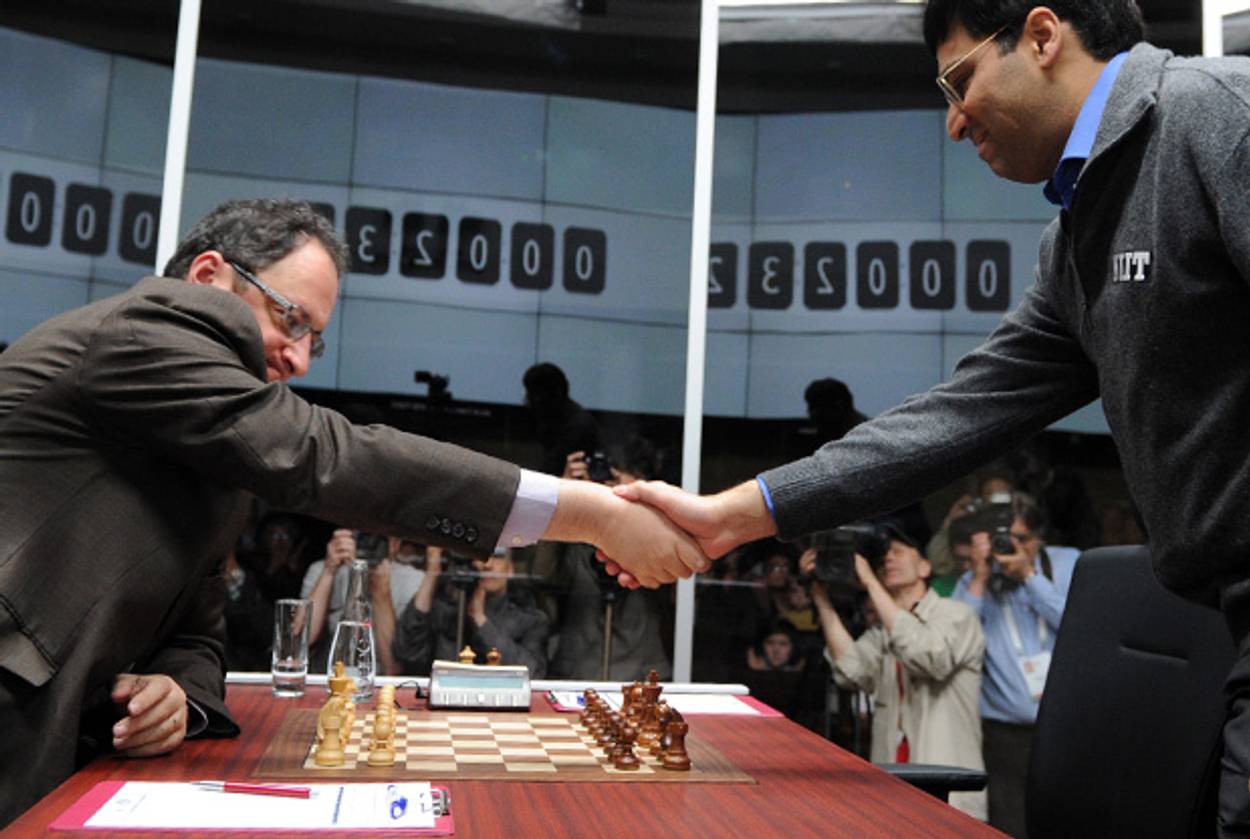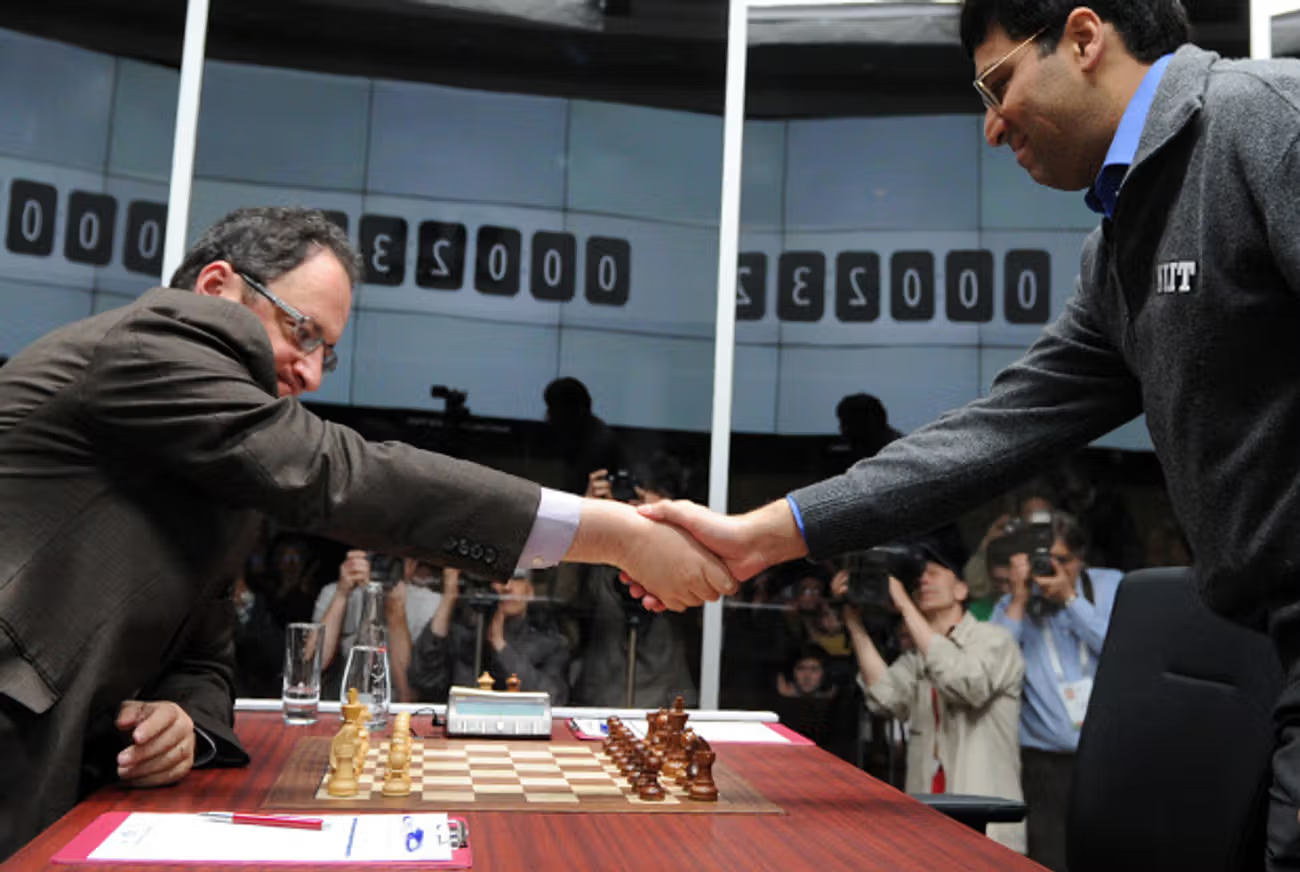Coalition of the Nerds
Israel and India, dominant at the World Chess Championship last week, share tourists, trade, and values




So, the conspiracy theorists were right: Indians and Israelis really have been plotting world domination. In a 20-day contest in Moscow that ended last week, 42-year-old Chennai native Viswanathan Anand and 43-year-old Israeli Boris Gelfand battled for the 2012 World Chess Championship. Anand, the defending world champion, held off his challenger, but not before being taken to a tie breaker.
Indians and Israelis ought to savor this rare moment of sporting glory. Not to put too fine a point on it, but try to imagine an Indian-Israeli final in any other sport.
Take soccer, the so-called beautiful game. India is ranked a lowly 158th in the world; Israel last qualified for the World Cup in 1970. Or how about the Olympics? In Bejing four years ago, Israel snagged a single bronze … for wind surfing. With one gold (shooting) and a pair of bronzes (wrestling and boxing), India didn’t exactly set the medals table alight either. Indeed, the classic Jewish joke from Airplane! works just as well with Indians. Light reading: Famous Hindu sporting legends. (Cricket, India’s national obsession, doesn’t count. Only 10 countries play it seriously, among them such sporting giants as Zimbabwe, Bangladesh, and Sri Lanka.)
Chess, though, is another matter. It’s the one international sport where India and Israel find themselves in the unfamiliar position of being in the top 10 teams in the world. Between them they have 65 grand masters—the sport’s highest rung—and 121 international masters.
But what if you’re one of those folks who doesn’t think a couple of overweight, bespectacled middle-aged guys hunched over a board qualifies as sport? Well, there’s always politics. In 1972, when Bobby Fischer and Boris Spassky squared off in Reykjavik for the so-called Match of the Century, the Cold War analogy virtually wrote itself. (Freedom won.) In the mid-1980s, the fabled rivalry between buttoned-down Anatoly Karpov and the flamboyant Garry Kasparov came to symbolize the struggle within the USSR between the Soviet establishment and reformers. In 1985, the brash 22-year-old Kasparov beat the Kremlin favorite to become the youngest-ever world champion.
Alas, Anand v. Gelfand doesn’t write itself quite as easily. To begin with, neither player exactly oozes charisma. Though Anand has won the so-called Chess Oscar six times, even his most partisan supporters won’t claim that he sets pulses racing among those who can’t tell their Ruy Lopez from their Queen’s Indian Defense. Your heart goes out to journalists struggling to make him sound interesting. (Hey, did you know he’s the only sportsman invited to a dinner by Prime Minister Manmohan Singh for President Barack Obama in 2010?!)
As for the low-key and gym-averse Gelfand, even if you forgive him for being born in Minsk it’s kind of hard to get over his choice of an Israeli city to emigrate to: Rishon LeZion. (What’s wrong with Tel Aviv, Boris?)
But enough naysaying. For supporters of the India-Israel relationship, Gelfand v. Anand reinforces a geopolitical fact: New Delhi and Jerusalem—and by extension Chennai and Rishon LeZion—share a special bond.
In the 20 years since the two countries established full diplomatic relations, two-way trade has rocketed from an anemic $180 million to an estimated $5 billion. A trip to India after compulsory military service is now a rite of passage for many young Israelis: About 40,000 of them visit India each year. (Though it isn’t clear how many carry chess boards in their backpacks.) Israeli and Indian technology and pharmaceutical firms have invested in each others’ economies.
Four years ago, scientists in southern India launched Tecsar, an Israeli spy satellite reportedly aimed at improving the monitoring of Iranian military movements. The following year, India launched a modified version of the satellite bought from Israel for itself.
Over the past decade, Israel has emerged as one of India’s biggest arms suppliers—second only to Russia, by some estimates—and India in turn is one of the Israeli defense industry’s largest export markets. Among India’s purchases: surveillance drones, surface-to-air missiles, advanced artillery, airborne radar, and sensors to track cross-border infiltration by terrorists into Indian Kashmir. The two countries are also working together on a joint missile-defense program.
For those who found the Cold War-era chill between India and Israel inexplicable, this warmth is only natural. Both India and Israel represent ancient civilizations whose land carries a special spiritual significance for most of its people. Despite living in tough neighborhoods, both have chosen democracy over dictatorship. Though the Arab Spring may change this, traditionally you could drive the 2,500 miles between New Delhi and Jerusalem without encountering another plural society whose leaders are regularly elected to office.
Despite what conspiracy theorists may say, neither country has a quarrel with Islam—both house Muslim populations that enjoy more rights than their coreligionists in many places—but both are threatened by radical Islamist ideology and its cousin, jihadist terrorism. As former British colonies, India and Israel are kissing cousins of the Anglosphere, lands with distinct cultures that benefit from the liberal international order upheld by American power.
Closer to home, the 3-million-strong Indian-American community sees the Jewish-American community as a role model. The Hindu American Foundation has sought guidance from the Simon Wiesenthal Center and the Anti-Defamation League as it battles discriminatory text books and sexy yoga commercials. The lobbying group USINPAC has co-hosted events on Capitol Hill with the influential AIPAC. (It has a ways to go, however, to match AIPAC’s influence.) More broadly, many Indians share the belief that, as the Indian-American author Parag Khanna has put it, “Jews and Indians are assimilators, maintaining traditional values but adapting to any national context.”
In short, there’s a lot more to the India-Israel relationship than a chess face-off. Though if the relationship is to attain its full potential, perhaps it’s time American Jews started paying more attention to another area of nerdy achievement: the spelling bee.
***
Like this article? Sign up for our Daily Digest to get Tablet Magazine’s new content in your inbox each morning.
Sadanand Dhume is a resident fellow at the American Enterprise Institute in Washington, D.C. Follow him on Twitter @dhume01
Sadanand Dhume is a resident fellow at the American Enterprise Institute in Washington, D.C. Follow him on Twitter @dhume01